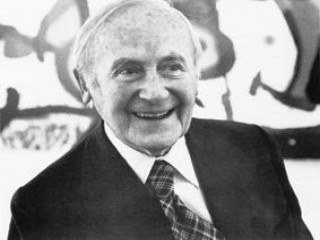
Joan Miro biography
Date of birth : 1893-04-20
Date of death : 1983-12-25
Birthplace : Barcelona, Spain
Nationality : Spanish
Category : Arts and Entertainment
Last modified : 2022-03-20
Credited as : Cubist artist, and painter, ceramist
7 votes so far
Early life and artistic training
Miró's father was a watchmaker and goldsmith. Both his father's background as an artisan and the austere Catalan landscape would be of great importance to his art. According to his parents' wishes, he attended a commercial college. He then worked for two years as a clerk in an office until he had a mental and physical breakdown. His parents took him for convalescence to an estate they bought especially for this purpose—Montroig, near Tarragona, Spain—and in 1912 they allowed him to attend an art school in Barcelona. His teacher at this school, Francisco Galí, showed a great understanding of his 18-year-old pupil, advising him to touch the objects he was about to draw, a procedure that strengthened Miró's feeling for the spatial quality of objects. Galí also introduced his pupil to examples of the latest schools of modern art from Paris as well as to the buildings of Antoni Gaudí, Barcelona's famous Art Nouveau architect.
From 1915 to 1919 Miró worked in Spain—in Barcelona, at Montroig, and on the island of Majorca—painting landscapes, portraits, and nudes in which he focused on the rhythmic interplay of volumes and areas of colour. He experimented with the boldly colourful Fauvist style, but his treatment of form was geometric, influenced by the work of Paul Cézanne and the Cubist artists.
From early in his career Miró sought to establish means of metaphorical expression—that is, to discover signs that stand for concepts of nature in a transcendent, poetic sense. He wanted to portray nature as it would be depicted by a primitive person or a child equipped with the intelligence of a 20th-century adult; in this respect, he had much in common with the Surrealists and Dadaists, two schools of modern artists who were striving to achieve similar aims by more intellectual means than those used by Miró.
Paris and early work
From 1919 onward Miró lived alternately in Spain and Paris. He was one of the many artists who made their way from abroad to Paris during the first two decades of the 20th century. Most of these foreign artists elected to become French citizens after coming into contact with the exciting French artistic metropolis, but Miró remained attached to his Catalan homeland.
In the early 1920s Miró combined meticulously detailed realism with abstraction in landscapes such as the renowned Farm (1921) and The Tilled Field (1923–24). He gradually removed the objects he portrayed from their natural context and reassembled them as if in accordance with a new, mysterious grammar, creating a ghostly, eerie impression.
In spite of his fame, however, Miró, a taciturn, introverted man, continued to devote himself exclusively to looking and creating. His art had developed slowly from his first clumsy attempts at expression to the apparently playful masterpieces of his later period. In his late works Miró employed an even greater simplification of figure and background; he sometimes created a composition merely by setting down a dot and a sensitive line on a sea-blue surface, as in Blue II (1961). The whimsical or aggressive irony of his earlier work gave way to a quasi-religious meditation.
In 1980, in conjunction with his being awarded Spain's Gold Medal of Fine Arts, a plaza in Madrid was named in Miró's honor.


















